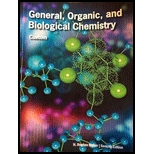
Concept explainers
(a)
Interpretation: Whether the boiling point will be the same or different for the compounds
Concept introduction: Lactic acid is an organic compound with the formula
(a)
Answer to Problem 18.49EP
The boiling point for
Explanation of Solution
The most of the properties of
(b)
Interpretation: Whether the optical activity will be the same or different for the compounds
Concept introduction: Lactic acid is an organic compound with the formula
(b)
Answer to Problem 18.49EP
The optical activity for
Explanation of Solution
The most of the properties of
Hence, the optical activity for
(c)
Interpretation: Whether the reaction with ethanol will be the same or different for the compounds
Concept introduction: Lactic acid is an organic compound with the formula
(c)
Answer to Problem 18.49EP
The the reaction with ethanol for
Explanation of Solution
The most of the properties of
Hence, the reaction with ethanol for
(d)
Interpretation: Whether the reaction with
Concept introduction: Lactic acid is an organic compound with the formula
(d)
Answer to Problem 18.49EP
The reaction with
Explanation of Solution
The two forms of lactic acid,
Hence, the reaction with
Want to see more full solutions like this?
Chapter 18 Solutions
General, Organic, and Biological Chemistry Seventh Edition
- 3. Draw the structures of phenyl chloride and benzyl chloride (the purpose of this is so that you can see how the “benz" prefix refers to something other than the simple benzene ring, and hence why benzoate has the structure it does). 4. Methyl benzoate can be formed from the esterification of benzoic acid and methanol, using sulfuric acid as a catalyst. Give an equation for this reaction.arrow_forward12. Give a reaction showing that benzoic acid behaves as an acid.arrow_forwardHydrolysis of the ester CH3-CH2-COO-CH2-CH2-CH3 in dilute acid, gives a. acetic acid and ethanol b. propanoic acid and ethanol c. propanoic acid and 1- propanol d. acetic acid and 1-propanolarrow_forward
- Which of the following statement is CORRECT about carboxylic acid? a. The direct conversion of a carboxylic acid to an amide is difficult due to amine basicity which tends to convert carboxylic acid to highly unreactive carboxylate ions. b. Carboxylic acids do not dissolve readily in water due to the non availability of the terminal hydrogen atom. c. Carboxylic acids are weak acids. The C=O push electron density towards the carbon so that hydrogen (H) is more easily lost. d. Carboxylic acids with more than six carbons are very soluble in water due to the presence of hydrogen bonding, but their conjugate base salts are sparingly water soluble.arrow_forward1. Give the reaction of linoelic acid that reacts with sulfuric acid 2. Give the reagent and the reaction conditions that would distinguish between the following compounds. Write equations for the reactions involved. -2-methylpentane and 2-methyl-2-pentenearrow_forwardThe solubility of butanoic acid in water is 60 mg/mL, while that of ethyl acetate is about 80 mg/mL. How will you account for this difference?arrow_forward
- 5. What products would result from the following processes? Write an equation for each reaction. a. 2-Methyl-2-butanol is subjected to controlled oxidation. b. 1-Propanol is heated to 140°C in the presence of sulfuric acid. c. 3-Pentanol is subjected to controlled oxidation. d. 3-Pentanol is heated to 180°C in the presence of sulfuric acid. e. 1-Hexanol is subjected to an excess of oxidizing agentarrow_forwardGive the products formed when Benzaldehyde and Benzoic Acid are treated with the given reagents. a. Tollen’s reagentb. phenylhydrazine, H+c. HCNarrow_forwardMCQ 6: The chemical reaction between carbonyl compounds and DNPH is an example of A. condensation reaction B. substitution reaction C. addition reaction D. elimination reactionarrow_forward
- 2. Alcohols Write the complete step-by-step mechanism for the reaction of 3-methyl-2-pentanol with sulfuric acid.arrow_forwardwhy n-hexanol has higher boiling point than n-hexane. why acetic acid is more acidic then butanoic acid. why sugar is soluble in water in terms of their molecular interactions.arrow_forwardWhich of the following carboxylic acid is toxic when ingested? a.Citric acid b.Malic acid c.Acetic acid d.Oxalic acid What is the general formula for Grignard reagents? a.RCOOH b.RMgX c.RX d.RCOX Oxidation of alkyl benzenes in the presence of Sulfuric acid will produce which carboxylic acid? a.Cyclohexanecarboxylic acid b.Benzoic acid c.Acrylic acid d.Fumaric acid What dicarboxylic acid contains six carbon atoms in its structure? a.Capric acid b.Pimelic acid c.Adipic acid d.Hexanoic acid Which of the following is an example of an unsaturated carboxylic acid? a.Succinic acid b.Formic acid c.Glycolic acid d.Acrylic acidarrow_forward
 Chemistry for Today: General, Organic, and Bioche...ChemistryISBN:9781305960060Author:Spencer L. Seager, Michael R. Slabaugh, Maren S. HansenPublisher:Cengage Learning
Chemistry for Today: General, Organic, and Bioche...ChemistryISBN:9781305960060Author:Spencer L. Seager, Michael R. Slabaugh, Maren S. HansenPublisher:Cengage Learning
